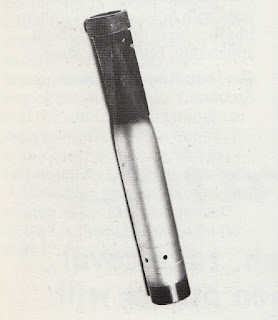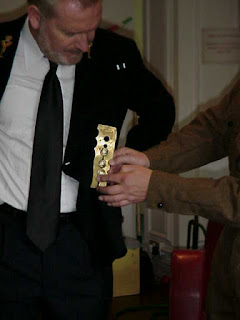World War II Teaching Sessions At Birmingham Museum…
Introduction…
I guess when I started working at the BM&AG in 1984, the only mention of WW2 was in a small area of the Local History section, Gallery 30 and near the Great Charles Street entrance, which of course would eventually become the site of the Learning Zone’s lunch area…
A splendid temporary exhibition called ‘A City At War’ was displayed in consecutive art galleries some years later, which even included a mock-up of a damaged Birmingham house, copied from a black and white photograph taken during the bombing of Birmingham and I would use that image in my WW2 sessions.

DAMAGED ANDERSON SHELTERS IN OLDKNOW ROAD, BIRMINGHAM... 
ORIGINAL PHOTOGRAPH OF THE DAMAGED HOUSE ON THE CORNER OF KENT STREET & GOOCH STREET, WHICH WAS 'BUILT' IN THE MUSEUM'S TEMPORARY 'A CITY AT WAR' GALLERY...
I am certain that to have kept that exhibition as a permanent memorial to WW2 in Birmingham would have attracted many more visitors to the BM&AG and although I taught a few sessions within the confines of the exhibition, understandably they were basically guided tours.
 |
| POSED IMAGE TO SHOW THAT 'EVEN WOMEN COULD ERECT AN ANDERSON SHELTER'. A SHOCKING PICTURE, REALLY... |
 |
| INCENDIARY BOMB... |
 |
| TYPICAL DISPLAY FROM 'A CITY AT WAR'... |
The Natural History Galleries, containing stuffed animals, birds, fossils and dinosaurs were eventually cleared out for the installation of ‘Light On Science’, an area for hands-on experimenting, following the closure of the Museum Of Science & Industry in Newhall Street. However, it was clear that eventually the new Millennium Point building of ‘Thinktank’ in Curzon Street would be where that type of display could find a permanent home.
The World War II role-play sessions in the gallery…
The stretch of galleries on the top floor of the BM&AG was finally set up to illustrate local history and one of the small areas constructed was a WW2 sitting room, containing lounge chairs, a table, a mock fireplace and of course artefacts like a stirrup pump and bucket, also a scoop for lifting an incendiary bomb into water or for dropping into a safe area outside the house. This room gave me the opportunity to devise a WW2 teaching session and I was pleased to be able to share it with Elfyn Morris, who would play the role of my brother Billy Atkins, a bearded Naval fellow. I would of course be Tommy Atkins, an infantry soldier…
 |
| BEFORE OUR FIRST EVER SESSION. THE IMAGES BELOW ARE ALL FROM OUR SESSIONS IN THE GALLERY... |
Elfyn managed to find a peaked Navy cap and a dark blue jacket to wear, whilst I had an army uniform of the West Yorkshire Regiment made for me. I bought puttees to wear round my lower legs, an army shirt and a tie, which was actually American…
We managed to do those first sessions in the gallery, as if the backdrop was our home setting. Colleague Ailyse Hancock, the teacher at Aston Hall, made a Powerpoint presentation of what we did and images from her smart piece of work appear below…
 |
| OUR STORY WAS SLIGHTLY DIFFERENT IN SOME WAYS BUT AILYSE CERTAINLY GAVE THE PARTICIPANTS SOMETHING TO WORK WITH BACK AT SCHOOL... |
However, Elfyn and I realised that we needed to set this session up inside my teaching space, which at that time was at the end of the gallery we had been performing in and indeed had been the Schools Liaison Department’s office area when I started working there in 1984, as mentioned elsewhere on this blog.

THIS IMAGE SHOWS HOW OPEN THE GALLERY WAS...
The essence of the original session…
My character was based upon a fictional newspaper photographer who had joined the West Yorkshire Regiment, despite being a Brummie, whilst most of the incidents discussed in the session were things which had happened to my father in his time with the Royal Warwickshire Regiment during WW2.
For the sessions as Tommy, my father had been invented as an air-raid warden, who was injured and in hospital, whilst my mum was described as an ambulance driver. My brother Billy was based on a real Brummie guy called Gilbert Holder, who had been killed during WW2 hostilities.
 |
| MEETING BILLY... |
A member of the Museum staff kindly allowed me to borrow what had been her father’s ARP warden’s shoulder bag, which still had some original bandages and first-aid items inside. Of course, I added more artefacts to the bag, including my dad’s sergeant’s whistle, his bicycle clips and his button-polishing stick. My dad’s 1935 bicycle was present in my teaching room too, although the guy who became the leader of the Schools Liaison Department, Richard Statham, insisted that it was bolted to the floor in case, er, it fell on a child…
 |
| DEMONSTRATING HOW A BUTTON STICK WOULD BE USED TO CLEAN UNIFORM BUTTONS WITHOUT GETTING POLISH ON THE UNIFORM ITSELF... |
He and the Museum staff would not allow me to have a real Anderson shelter in my room either, nor a Morrison shelter, in case a child touched any small areas of rust… The Museum had examples of both shelters in its vast collection of artefacts, neither of which would ever be placed on display…
Of course, no child was ever allowed near my dad’s bike and no child would ever have been allowed near either shelter. I was also shocked one day to find that the standard lamp in my room had also been screwed to the floor and I wasn’t able to change its position… Hmm, health & safety had gone a little over the top under Mr Statham’s managership…
Luckily, I was able to use a table against a wall with a fire-guard placed round three sides of it to illustrate what a Morrison shelter looked like, explaining to the children that my parents weren’t able to afford a real one but it would do the job of preventing pieces of shrapnel from striking anyone hiding inside.
A stirrup pump in full working order was available to me for demonstration, as was a bomb scoop, both used for dealing with an incendiary bomb which had fallen into the house.
All the different kinds of gas masks were shown too, including a magnificent horse’s gas mask, which caused amazement amongst visiting children.
 |
| A CHILD'S 'MICKEY MOUSE' GAS MASK... |
 |
| A GAS MASK DESIGNED FOR A BABY... |
My room setting was basically in 1940s style and of course visually, the visiting pupils would surely acquire knowledge about home life in wartime. The fireplace, the coal, the ashtray, the old telephone, the Christmas decorations, the tree-branch painted with cricket boot whitener to be used as a small Christmas tree, plus photos and a host of other items would all be discussed during the two-hour sessions.
 |
| SHOWING A PICTURE OF MARJ... |
 |
| THE WEDDING IMAGE... |
 |
| THOUGHTFUL... |
However, when I worked with Elfyn, we used a scenario in which I began the session asleep on a chair and when I was aroused by Elfyn, aka Billy, the children were in the room too. It was a real shock but joyous to see Billy home for Christmas and Elfyn and I worked the sessions with no script at all but we simply played off each other.
Elfyn’s guitar was in the room and we performed ‘White Christmas’ for the children, with me doing the singing, clutching a pipe like Bing Crosby…
 |
| ELFYN ACCOMPANIES ME... |
Billy would then say he had to leave and as he said farewell, I would sit back on the chair asleep, for the whole thing was meant to be a dream… It worked well enough and the children were totally shocked that Billy had been an apparition…
 |
| CHATTING ABOUT MY FOOTBALL SHIN-PADS... |
However, no matter how enjoyable, informative and amusing the sessions had been, a third set of Christmas sessions together was denied to Elfyn and me, for he was told he needed to book sessions at his own site, Sarehole Mill in the weeks before Christmas…

OPENING OUR CHRISTMAS PRESENTS TO EACH OTHER.
BOTH GIFTS WERE IDENTICAL SOCKS...
Next article: doing the WW2 Christmas sessions alone and when, on one occasion, Richard Statham made a cameo appearance as an ARP warden. That particular day will live long in my memory…

















No comments:
Post a Comment